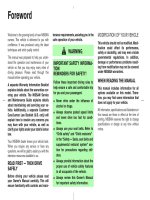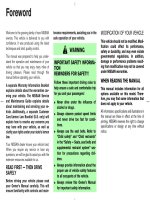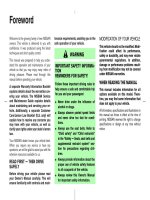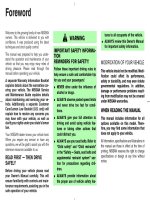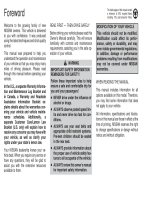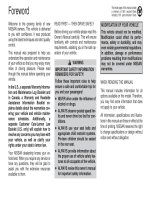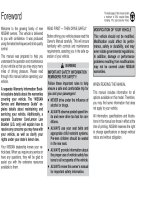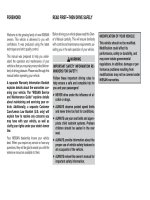Nissan 350Z 2004 owner manual - Sách hướng dẫn sử dụng xe Nissan 350Z đời 2004
Bạn đang xem bản rút gọn của tài liệu. Xem và tải ngay bản đầy đủ của tài liệu tại đây (2.85 MB, 263 trang )
Foreword
Welcome to the growing family of new NISSAN
owners. This vehicle is delivered to you with
confidence. It was produced using the latest
techniques and strict quality control.
This manual was prepared to help you under-
stand the operation and maintenance of your
vehicle so that you may enjoy many miles of
driving pleasure. Please read through this
manual before operating your vehicle.
A separate Warranty Information Booklet
explains details about the warranties cov-
ering your vehicle. The NISSAN Service
and Maintenance Guide explains details
about maintaining and servicing your ve-
hicle. Additionally, a separate Customer
Care/Lemon Law Booklet (U.S. only) will
explain how to resolve any concerns you
may have with your vehicle, as well as
clarify your rights under your state’s lemon
law.
Your NISSAN dealer knows your vehicle best.
When you require any service or have any
questions, we will be glad to assist you with the
extensive resources available to us.
READ FIRST — THEN DRIVE
SAFELY
Before driving your vehicle please read
your Owner’s Manual carefully. This will
ensure familiarity with controls and main-
tenance requirements, assisting you in the
safe operation of your vehicle.
WARNING
IMPORTANT SAFETY INFORMA-
TION
REMINDERS FOR SAFETY!
Follow these important driving rules to
help ensure a safe and comfortable trip
for you and your passengers!
¼ Never drive under the influence of
alcohol or drugs.
¼ Always observe posted speed limits
and never drive too fast for condi-
tions.
¼ Always use your seat belts. Refer to
“Child safety” and “Child restraints”
in the “Safety — Seats, seat belts and
supplemental restraint system” sec-
tion for precautions regarding chil-
dren.
¼ Always provide information about the
proper use of vehicle safety features
to all occupants of the vehicle.
¼ Always review this Owner’s Manual
for important safety information.
MODIFICATION OF YOUR VEHICLE
This vehicle should not be modified. Modi-
fication could affect its performance,
safety or durability, and may even violate
governmental regulations. In addition,
damage or performance problems result-
ing from modification may not be covered
under NISSAN warranties.
WHEN READING THE MANUAL
This manual includes information for all
options available on this model. There-
fore, you may find some information that
does not apply to your vehicle.
All information, specifications and illustrations in
this manual are those in effect at the time of
printing. NISSAN reserves the right to change
specifications or design at any time without
notice.
੬ 03.6.19/Z33-D/V5.0 ੭
IMPORTANT INFORMATION
ABOUT THIS MANUAL
You will see various symbols in this manual.
They are used in the following ways:
WARNING
This is used to indicate the presence of a
hazard that could cause death or serious
personal injury. To avoid or reduce the
risk, the procedures must be followed
precisely.
CAUTION
This is used to indicate the presence of a
hazard that could cause minor or moder-
ate personal injury or damage to your
vehicle. To avoid or reduce the risk, the
procedures must be followed carefully.
If you see this symbol, it means “Do not do
this” or “Do not let this happen”.
If you see a symbol similar to these in an
illustration, it means the arrow points to the front
of the vehicle.
Arrows in an illustration that are similar to these
indicate movement or action.
Arrows in an illustration that are similar to these
call attention to an item in the illustration.
CALIFORNIA PROPOSITION 65
WARNING
WARNING
Engine Exhaust, some of its constituents,
and certain vehicle components contain
or emit chemicals known to the State of
California to cause cancer and birth de-
fects or other reproductive harm. In ad-
dition, certain fluids contained in ve-
hicles and certain products of
component wear contain or emit chemi-
cals known to the State of California to
cause cancer and birth defects or other
reproductive harm.
© 2003 NISSAN MOTOR CO., LTD.
TOKYO, JAPAN
All rights reserved. No part of this Owner’s Manual may be
reproduced or stored in a retrieval system, or transmitted
in any form, or by any means, electronic, mechanical,
photocopying, recording or otherwise, without the prior
written permission of Nissan Motor Co., Ltd.
SIC0697
੬ 03.6.19/Z33-D/V5.0 ੭
Welcome To The World Of NISSAN
Your new NISSAN is the result of our dedication to
produce the finest in safe, reliable and economical
transportation. Your vehicle is the product of a
successful worldwide company that manufactures
cars and trucks in over 17 countries and distributes
them in 170 nations.
NISSAN vehicles are designed and manufactured
by Nissan Motor Co., Ltd. which was founded in
Tokyo, Japan in 1933, and NISSAN affiliates world
wide, collectively growing to become the fifth
largest automaker in the world. In addition to cars
and trucks, NISSAN also makes forklift trucks,
marine engines, boats and other diversified prod-
ucts.
NISSAN has made a substantial and growing
investment in North America. NISSAN’s commit-
ment is nearly $4 billion dollars in capital invest-
ments in facilities across the continent. Some of
the facilities include the Nissan Manufacturing
facility in Smyrna, Tennessee, vehicle styling de-
sign at Nissan Design America, Inc. in San Diego,
California, and engineering at Nissan Technical
Center North America in Farmington Hills, Michi-
gan. Additionally, NISSAN employs nearly 18,000
people throughout the United States, Canada, and
Mexico. An additional 71,000 people work for the
1,500 NISSAN and INFINITI dealers across North
America.
NISSAN is also a substantial contributor to the
Canadian economy. Nissan Canada Inc., its sup-
pliers and over 140 dealers employ approximately
4,500 people. These include company employees
and the staffs of NISSAN dealers all across
Canada. In addition, many Canadians work for
companies that supply NISSAN and NISSAN deal-
ers with materials and services ranging from op-
eration of port facilities and transportation services
to the supply of lubricants, parts and accessories.
NISSAN pioneered the use of electronics and
computers in automobiles, and has led the industry
in improving both performance and fuel efficiency
through new engine designs and the use of syn-
thetic materials to reduce vehicle weight. The
company has also developed ways to build quality
into its vehicles at each stage of the production
process, both through extensive use of automation
and — most importantly — through an awareness
that people are the central element in quality
control.
From the time the parts arrived from our suppliers
until you took delivery of your new NISSAN, dozens
of checks were made to ensure that only the best
job was being done in producing and delivering
your vehicle. NISSAN also takes great care to
ensure that when you take your NISSAN to your
dealer for maintenance, the service technician will
perform his work according to the quality stan-
dards that have been established by NISSAN.
Safety has also been built into your NISSAN. As
you know, seat belts are an integral part of the
safety systems that will help protect you and your
passengers in the event of a sudden stop or an
accident. We urge you to use the seat belts every
time you drive the vehicle.
The NISSAN story of growth and achievement
reflects our major goal: to provide you, our cus-
tomer, with a vehicle that is built with quality and
craftsmanship—aproductthatwecanbeproud
to build and you can be proud to own.
WFW0002
੬ 03.6.19/Z33-D/V5.0 ੭
NISSAN CUSTOMER CARE PROGRAM
NISSAN CARES
Both NISSAN and your NISSAN dealer are dedicated to serving all your automotive needs. Your satisfaction with your vehicle and your NISSAN dealer
are our primary concerns. Your NISSAN dealer is always available to assist you with all your automobile sales and service needs.
However, if there is something that your
NISSAN dealer cannot assist you with or you
would like to provide NISSAN directly with
comments or questions, please contact our
(NISSAN’s) Consumer Affairs Department us-
ing our toll-free number:
For U.S. mainland customers
1-800-NISSAN-1
(1-800-647-7261)
For Hawaii customers
1-808-836-0888 (Oahu Number)
For Canadian customers
1-800-387-0122
The Consumer Affairs Department will ask for
the following information:
— Your name, address, and telephone
number
— Vehicle identification number (on dash panel)
— Date of purchase
— Current odometer reading
— Your NISSAN dealer’s name
— Your comments or questions
OR
You can write to NISSAN with the information
on the left at:
For U.S. mainland and Alaska customers
Nissan North America, Inc.
Consumer Affairs Department
P.O. Box 191
Gardena, California 90248-0191
For Hawaii customers
Nissan Motor Corporation in Hawaii
2880 Kilihau St.
Honolulu, Hawaii 96819
For Canada customers
Nissan Canada Inc.
5290 Orbitor Drive
Mississauga, Ontario L4W 4Z5
We appreciate your interest in NISSAN and thank you for buying a quality NISSAN vehicle.
੬ 03.6.19/Z33-D/V5.0 ੭
Table of
Contents
Illustrated table of contents
Safety — Seats, seat belts and supplemental
restraint system
Instruments and controls
Pre-driving checks and adjustments
Heater, air conditioner and audio systems
Starting and driving
In case of emergency
Appearance and care
Maintenance and do-it-yourself
Technical and consumer information
Index
੬ 03.6.19/Z33-D/V5.0 ੭
0 Illustrated table of contents
Exterior front 0-2
Exterior rear 0-3
Instrument panel 0-5
Engine compartment check locations 0-6
੬ 03.6.19/Z33-D/V5.0 ੭
1. Hood (P.3-9)
2. Windshield wiper and washer
— Switch (P.2-20)
— Wiper replacement (P.8-20)
3. Interior light (P.2-38)
4. Power windows (P.2-36)
5. Towing hook installation (P.6-10)
6. Headlight, park and turn signal lights
— Switch (P.2-22)
— Bulb replacement (P.8-25)
7. Tires
— Wheel and tires (P.8-30, P.9-9)
— Flat tire (P.6-2)
8. Outside mirrors (P.3-17)
9. Doors
— Keys (P.3-2)
— Door locks (P.3-3)
— Keyfob (P.3-4)
SSI0001
EXTERIOR FRONT
0-2 Illustrated table of contents
੬ 03.6.19/Z33-D/V5.0 ੭
Coupe models
1. Antenna (P.4-20)
2. Rear hatch release switch (P.3-10)
3. Rear window defroster (P.2-21)
4. High-mounted stop light (Bulb) (P.8-27)
5. Rear window wiper and washer
(P.2-21)
6. License plate lights (Bulb replacement)
(P.8-27)
7. Rear hatch release (secondary) (P.3-10)
8. Luggage compartment light (P.2-39, P.8-27)
9. Back-up, Turn signal light (Bulb replacement)
(P.8-27)
10. Side marker, Stop/Tail light (Bulb replace-
ment) (P.8-27)
11. Fuel
— Fuel filler lid (P.3-13)
— Fuel recommendation (P.9-3)
SSI0002
EXTERIOR REAR
Illustrated table of contents 0-3
੬ 03.6.19/Z33-D/V5.0 ੭
Roadster models
1. Antenna (P.4-20)
2. Trunk lid release switch (P.3-11)
3. Trunk light (P.2-39, P.8-27)
4. High-mounted stop light (Bulb) (P.8-27)
5. Rear window defroster (P.2-21)
6. Soft top (P.3-18)
7. Interior trunk lid release (P.3-12)
8. License plate lights (Bulb replacement)
(P.8-27)
9. Back-up, Turn signal light (Bulb replacement)
(P.8-27)
10. Side marker, Stop/Tail light (Bulb replace-
ment) (P.8-27)
11. Fuel
— Fuel filler lid (P.3-13)
— Fuel recommendation (P.9-3)
SSI0003
0-4 Illustrated table of contents
੬ 03.6.19/Z33-D/V5.0 ੭
1. Headlight/turn signal switch (P.2-22)
2. Instrument brightness control switch
(P.2-24)
3. Driver supplemental air bag (P.1-10)/Horn
(P.2-25)
4. Meters/gauges (P.2-3)
5. Cruise control main/set switch (P.5-15)
6. Trip computer mode/setting switch (P.2-8)
7. Windshield wiper/washer switch (P.2-20)
8. Center ventilator (P.4-2)
9. Cup holder (P.2-32)
10. Passenger supplemental air bag (P.1-10)
11. Side ventilators (P.4-2)
12. VDC (Vehicle dynamic control) OFF switch
(P.2-27) or TCS (Traction control system)
OFF switch (P.2-27)
13. Soft top operating switch (Roadster mod-
els) (P.3-18)
14. Fuel filler lid opener switch (P.3-13)
15. Hood lock release handle (P.3-9)
16. Fuse box (P.8-22)
17. Tilting steering wheel lock lever (P.3-15)
18. Ignition switch (P.5-5)
19. Navigation system* or Instrument pocket
(P.2-30)
20. Rear window (and outside mirror) defroster
switch (P.2-21)
21. Heater/air conditioner control (P.4-3)
22. Audio system (P.4-6)/Clock (P.2-28)
23. Heated seat switch (P.2-26)
24. Hazard warning flasher switch (P.2-25)
25. Ashtray (P.2-29) or Tray (P.2-31)
26. Power outlet (P.2-28)
See the page indicated in parentheses for
operating details.
*: Refer to the separate Navigation System
Owner’s Manual.
SIC2268
INSTRUMENT PANEL
Illustrated table of contents 0-5
੬ 03.6.19/Z33-D/V5.0 ੭
1. Fuse/fusible link holder (P.8-22)
2. Battery (P.8-15)
3. Engine oil filler cap (P.8-10)
4. Brake fluid reservoir (P.8-13)
5. Clutch fluid reservoir (M/T models) (P.8-14)
6. Window washer fluid reservoir (P.8-14)
7. Power steering fluid reservoir (P.8-13)
8. Engine coolant reservoir (P.8-8)
9. Radiator filler cap (P.8-9)
10. Engine oil dipstick (P.8-10)
11. Air cleaner (P.8-18)
Do not tamper with the strut tower bar
adjustment
k
A
. The strut tower bar has
been adjusted to the most suitable posi-
tion at the factory.
CAUTION
Tampering with the strut tower bar ad-
justment may cause a noise while driv-
ing or damage to the hood or engine.
SDI1519
ENGINE COMPARTMENT CHECK
LOCATIONS
0-6 Illustrated table of contents
੬ 03.6.19/Z33-D/V5.0 ੭
1 Safety — Seats, seat belts and supple-
mental restraint system
Seats 1-2
Front manual seat adjustment
(for Coupe models) 1-3
Front power seat adjustment
(for Coupe models — if so equipped) 1-4
Front power seat adjustment
(for Roadster models) 1-5
Seat lifter (for driver’s seat) 1-7
Tilting and reclining passenger’s seat from driver’s
seat 1-7
Head restraint adjustment 1-9
Supplemental restraint system 1-10
Precautions on supplemental restraint system 1-10
Components of the supplemental restraint
system 1-15
Supplemental air bag warning labels 1-20
Supplemental air bag warning light 1-21
Seat belts 1-23
Precautions on seat belt usage 1-23
Child safety 1-25
Obtaining an air bag ON/OFF switch 1-25
After an air bag ON/OFF switch is installed 1-25
Pregnant women 1-26
Injured persons 1-26
Three-point type seat belt 1-26
Seat belt extenders 1-28
Seat belt maintenance 1-29
Child restraints 1-29
Precautions on child restraints 1-29
Top tether strap child restraint (Coupe models) 1-31
Installation on front passenger seat 1-32
੬ 03.6.19/Z33-D/V5.0 ੭
WARNING
¼ Do not ride in a moving vehicle when
the seatback is reclined. This can be
dangerous. The shoulder belt will not
be against your body. In an accident
you could be thrown into it and re-
ceive neck or other serious injuries.
You could also slide under the lap
belt and receive serious internal
injuries.
¼ For most effective protection when
the vehicle is in motion, the seat
should be upright. Always sit well
back in the seat and adjust the seat
belt properly. See “Precautions on
seat belt usage” later in this section.
SSS0133
SEATS
1-2 Safety — Seats, seat belts and supplemental restraint system
੬ 03.6.19/Z33-D/V5.0 ੭
FRONT MANUAL SEAT
ADJUSTMENT (for Coupe models)
WARNING
¼ Do not adjust the driver’s seat while
driving so full attention may be given
to vehicle operation. The seat may
move suddenly and could cause loss
of control of the vehicle.
¼ After adjustment, gently rock in the
seat to make sure it is securely
locked.
k
1
Forward and backward
Pull the lever up while you slide the seat forward
or backward to the desired position. Release the
lever to lock the seat in position.
When sliding the passenger’s seat backward,
be careful not to crush items in the seatback
pocket against the rear floor box.
k
2
Reclining
To recline the seatback, pull the lever up and
lean back. To bring the seatback forward again,
pull the lever and move your body forward. The
seatback will move forward.
The reclining feature allows adjustment of the
seatback for occupants of different sizes to help
obtain proper seat belt fit. (See “Precautions on
seat belt usage” later in this section.) The seat-
back can also be reclined to allow occupants to
sleep when the vehicle is stopped.
SSS0200
Safety — Seats, seat belts and supplemental restraint system 1-3
੬ 03.6.19/Z33-D/V5.0 ੭
FRONT POWER SEAT
ADJUSTMENT (for Coupe models —
if so equipped)
WARNING
¼ Do not adjust the driver’s seat while
driving so full attention may be given
to vehicle operation.
¼ Do not leave children unattended in-
side the vehicle. They could unknow-
ingly activate switches or controls.
Unattended children could become
involved in serious accidents.
Operating tips
¼ The seat motor has an auto-reset overload
protection circuit. If the motor stops during
operation, wait 30 seconds, then reactivate
the switch.
¼ Do not operate the power support seat
for a long period of time when the engine is
off. This will discharge the battery.
k
1
Forward and backward
Moving the sliding switch forward or backward
will slide the seat forward or backward to the
desired position.
When sliding the passenger’s seat backward,
be careful not to crush items in the seatback
pocket against the rear floor box.
k
2
Reclining (for driver’s seat)
Move the reclining switch backward until the
desired angle is obtained. To bring the seatback
forward, move the switch forward and move your
body forward. The seatback will move forward.
k
2
Reclining (for passenger’s seat)
The passenger’s seat is equipped with a manual
lever for reclining. See “Front manual seat ad-
justment” earlier in this section.
The reclining feature allows adjustment of the
seatback for occupants of different sizes to help
obtain proper seat belt fit. (See “Precautions on
seat belt usage” later in this section.) The seat-
back can also be reclined to allow occupants to
sleep when the vehicle is stopped.
SSS0201
1-4 Safety — Seats, seat belts and supplemental restraint system
੬ 03.6.19/Z33-D/V5.0 ੭
FRONT POWER SEAT
ADJUSTMENT (for Roadster models)
WARNING
¼ Do not adjust the driver’s seat while
driving so full attention may be given
to vehicle operation.
¼ Do not leave children unattended in-
side the vehicle. They could unknow-
ingly activate switches or controls.
Unattended children could become
involved in serious accidents.
Operating tips
¼ The seat motor has an auto-reset overload
protection circuit. If the motor stops during
operation, wait 30 seconds, then reactivate
the switch.
¼ Do not operate the power support seat
for a long period of time when the engine is
off. This will discharge the battery.
k
1
Forward and backward
Moving the sliding switch forward or backward
will slide the seat forward or backward to the
desired position.
When sliding the passenger’s seat backward,
be careful not to crush items in the seatback
pocket against the rear floor box.
k
2
Reclining
Move the reclining switch backward until the
desired angle is obtained. To bring the seatback
forward, move the switch forward and move your
body forward. The seatback will move forward.
The reclining feature allows adjustment of the
seatback for occupants of different sizes to help
obtain proper seat belt fit. (See “Precautions on
seat belt usage” later in this section.) The seat-
back can also be reclined to allow occupants to
sleep when the vehicle is stopped.
Automatic passenger seatback tilt
function
The passenger seatback will automatically tilt
forward and backward during the soft top
open/close operation. If you need to cancel this
function or when a child restraint is installed in
the passenger’s seat, push the seatback tilt
cancel switch to the CANCEL position. For more
SSS0271
Safety — Seats, seat belts and supplemental restraint system 1-5
੬ 03.6.19/Z33-D/V5.0 ੭
information about operation conditions, see
“Soft top operation” in the “3. Pre-driving checks
and adjustments” section. For the cancel switch,
see “Tilting and reclining passenger’s seat from
driver’s seat” later in this section.
Ventilated net seats (if so equipped)
The ventilated net seats are designed for good
ventilation while driving. Net cloth is used on the
surface of the seatback and the cushion as
shown.
CAUTION
¼ The seat is made of netted materials.
Be careful not to snag your jewelry,
such as a ring, bracelet or watch, on
the seat.
¼ When using these seats, avoid wear-
ing clothing with soft fabrics (wool,
etc.). Clothing may be damaged as it
rubs against the netted material.
SSS0272
1-6 Safety — Seats, seat belts and supplemental restraint system
੬ 03.6.19/Z33-D/V5.0 ੭
SEAT LIFTER (for driver’s seat)
Type A
Turn the dial and adjust the angle of the seat
cushion to the desired position.
Type B
Turn either dial to adjust the angle and height of
the seat cushion to the desired position.
TILTING AND RECLINING
PASSENGER’S SEAT FROM
DRIVER’S SEAT
The passenger seatback can be adjusted from
the driver’s seat to make it easier for the driver to
use the rear parcel box or rear floor box, or to
help the passenger get in the vehicle.
Coupe models (manual type)
To tilt or recline the passenger seatback, pull up
the lever
k
A
located on the back side of it, and
move the seatback forward or backward.
SSS0202
Type A
SPA1715
Type B
SSS0203
Coupe models
Safety — Seats, seat belts and supplemental restraint system 1-7
੬ 03.6.19/Z33-D/V5.0 ੭
Roadster models (power type)
The power seatback tilt switch k
B
and the
seatback tilt cancel switch
k
C
are located on the
back side of the passenger seatback as shown.
Tilting/reclining operation:
To tilt the passenger seatback forward, push the
top (
side) of the power seatback tilt
switch
k
B
for more than 0.5 seconds. The
seatback will automatically tilt forward. To stop
the movement, push the top or bottom of the
switch.
To tilt or adjust the seatback backward, push
and hold the bottom (
side) of the power
seatback tilt switch. While the switch is held
down, the seatback will move backward to the
original position that was last selected using the
reclining switch (located on the seat cushion).
Release the switch to stop the movement.
Operation conditions:
The power seatback tilt switch does not activate
under the following conditions.
¼ when the passenger seat sliding/reclining
switches on the seat cushion are being op-
erated.
¼ when the seat tilt cancel switch is in the
CANCEL position. (See “Seatback tilt cancel
switch” later in this section.)
¼ when the passenger seat belt is fastened.
¼ when the vehicle speed reaches 4 MPH (7
km/h) and more.
The automatic tilting/reclining movement will be
stopped:
¼ when any of the above 4 conditions occur.
¼ when the power seatback tilt switch (top or
bottom) is pushed again.
¼ when the seatback is moved with the soft top
open/close operation.
When this interruption occurs, you cannot move
the seatback backward from the stopped posi-
tion with the power seatback tilt switch. Use the
reclining switch (on the seat cushion) to select
the seatback position.
SSS0273
Roadster models — Type A
SSS0274
Roadster models — Type B
1-8 Safety — Seats, seat belts and supplemental restraint system
੬ 03.6.19/Z33-D/V5.0 ੭
Seatback tilt cancel switch:
When the seatback tilt cancel switch
k
C
is
pushed to the CANCEL position, the
tilting/reclining operation using the power seat-
back tilt switch
k
B
will be cancelled. Only the
sliding/reclining switches (located on the seat
cushion) are operational. Push the seatback tilt
cancel switch to the AUTO position to reactivate
the power seatback tilt switch.
This cancel switch is linked with the automatic
passenger seatback tilt function of the soft top
operation. See “Soft top operation” in the “3.
Pre-driving checks and adjustments” section.
CAUTION
When a child restraint is installed in the
passenger seat, be sure to turn the seat-
back tilt cancel switch to the CANCEL
position. Otherwise, the child restraint
may be damaged.
HEAD RESTRAINT ADJUSTMENT
To raise the head restraint, just pull it up. To
lower, push the lock knob
k
A
and push the head
restraint down.
The ventilated net seats (if so equipped for
Roadster models) have non-adjustable head
restraints.
SSS0275 SSS0204
Safety — Seats, seat belts and supplemental restraint system 1-9
੬ 03.6.19/Z33-D/V5.0 ੭
Adjust the head restraints so the center is level
with the center of your ears.
WARNING
Head restraints should be adjusted
properly as they may provide significant
protection against injury in an accident.
Do not remove them. Check the adjust-
ment after someone else uses the seat.
PRECAUTIONS ON
SUPPLEMENTAL RESTRAINT
SYSTEM
This Supplemental Restraint System (SRS) sec-
tion contains important information concerning
the driver and passenger front impact supple-
mental air bags, front seat side-impact supple-
mental air bags, curtain side-impact air bags and
front seat pre-tensioner seat belts.
Supplemental front-impact air bag system:
This system can help cushion the impact force to
the face and chest of the driver and front
passenger in certain frontal collisions.
Supplemental side-impact air bag system
(if so equipped): This system can help cushion
the impact force to the chest area of the driver
and front passenger in certain side impact colli-
sions. The front seat side-impact supplemental
air bags are designed to inflate on the side
where the vehicle is impacted.
Supplemental curtain side-impact air bag
system (if so equipped for Coupe models):
This system can help cushion the impact force to
the head of occupants in certain side impact
collisions. The curtain side-impact air bags are
designed to inflate on the side where the vehicle
is impacted.
The supplemental restraint system is designed
to supplement the crash protection provided
by the driver and passenger seat belts and is
not a substitute for them. Seat belts should
always be correctly worn and the occupant
seated a suitable distance away from the steer-
ing wheel, instrument panel, door finishers and
side roof rails. (See “Seat belts” later in this
section for instructions and precautions on seat
belt usage.)
After turning the ignition key to the ON
position, the supplemental air bag warning
light illuminates. The supplemental air bag
warning light will turn off after about 7
seconds if the systems are operational.
SSS0178
SUPPLEMENTAL RESTRAINT
SYSTEM
1-10 Safety — Seats, seat belts and supplemental restraint system
੬ 03.6.19/Z33-D/V5.0 ੭
WARNING
¼ The supplemental front air bags ordi-
narily will not inflate in the event of a
side impact, rear impact, roll over, or
lower severity frontal collision. Al-
ways wear your seat belts to help
reduce the risk or severity of injury in
various kinds of accidents.
¼ The seat belts and the supplemental
front air bags are most effective
when you are sitting well back and
upright in the seat. Front air bags
inflate with great force. If you are
unrestrained, leaning forward, sitting
sideways or out of position in any
way, you are at greater risk of injury
or death in a crash. You may also
receive serious or fatal injuries from
the supplemental front air bag if you
are up against it when it inflates.
Always sit back against the seatback
and as far away as practical from the
steering wheel or instrument panel.
Always use the seat belts.
¼ The driver and front passenger seat
belt buckles are equipped with sen-
sors that detect if the seat belts are
fastened. The air bag system moni-
tors the severity of a collision and
then inflates the air bags based on
belt usage. Failure to properly wear
seat belts can increase the risk or
severity of injury in an accident.
¼ Keep hands on the outside of the
steering wheel. Placing them inside
the steering wheel rim could increase
the risk that they are injured when
the supplemental front air bag in-
flates.
SSS0131
Safety — Seats, seat belts and supplemental restraint system 1-11
੬ 03.6.19/Z33-D/V5.0 ੭
SSS0132 SSS0016
1-12 Safety — Seats, seat belts and supplemental restraint system
੬ 03.6.19/Z33-D/V5.0 ੭
SSS0006
SSS0007
SSS0008
SSS0009
SSS0099
SSS0100
Safety — Seats, seat belts and supplemental restraint system 1-13
੬ 03.6.19/Z33-D/V5.0 ੭
WARNING
¼ Never let children 12 or under ride in
this vehicle. Do not attempt to hold
them in your lap or arms. Some ex-
amples of dangerous riding positions
are shown in the previous illustra-
tions.
¼ Children may be severely injured or
killed when the supplemental front
air bags or supplemental side and
curtain side-impact air bags (if so
equipped) inflate.
¼ Also never install a child restraint in
the front seat. An inflating supple-
mental front air bag could seriously
injure or kill your child.
¼ For information about installing an
air bag ON/OFF switch in your ve-
hicle so children can be transported,
see “Obtaining an air bag ON/OFF
switch” later in this section.
WARNING
Supplemental side air bag and curtain
side-impact air bag (if so equipped):
¼ The supplemental side air bag and
curtain side-impact air bag ordinarily
will not inflate in the event of a fron-
tal impact, rear impact, rollover or
lower severity side collision. Always
wear your seat belts to help reduce
the risk or severity of injury in various
kinds of accidents.
¼ The seat belts, the supplemental side
air bag and curtain side-impact air
bag are most effective when you are
sitting well back and upright in the
seat. The side air bag and curtain
side-impact air bag inflate with great
force. Do not allow anyone to place
their hand, leg or face near the side
air bag on the side of the seatback of
the front seat or near the side roof
rails. Do not allow anyone sitting in
the front seat to extend their hand
SSS0101
SSS0159
1-14 Safety — Seats, seat belts and supplemental restraint system
੬ 03.6.19/Z33-D/V5.0 ੭

